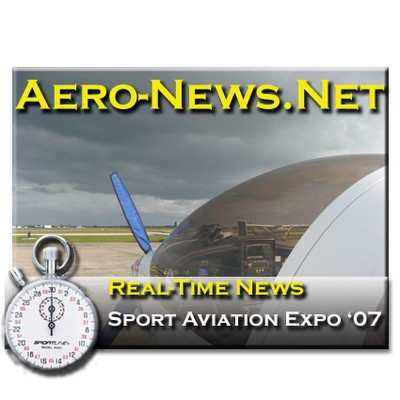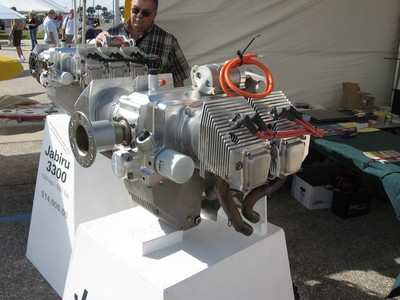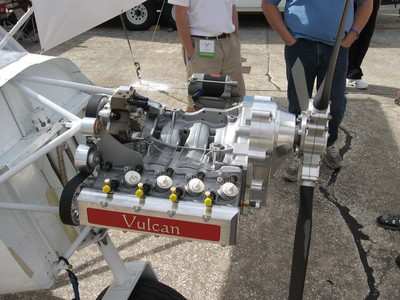LSA Potential Draws Small Shops into Market
by ANN Correspondent Paul Plack
Looking around at the recent US Sport Aviation Expo in Sebring,
FL, it was hard not to conclude that it's a great time to be Rotax.
While homebuilders on tight budgets like to grouse about the
company's pricing, the engines -- both two- and four-stroke -- have
earned their status. In addition to good power-to-weight ratios,
the engines have been thoroughly proven, and enjoy broad parts and
service availability. The geared reduction drives allow driving
large, efficient propellers. Volume production means quick
delivery. For many LSA manufacturers, Rotax is just hard to
beat.

But people keep trying! In years past, engine development was a
capital-intensive process best left to big companies (or skillful
stock pitchmen). Today, the blooming capabilities and falling
prices of CNC (computer numeric control) machining equipment and
CADD (computer-aided drafting and design) software allow small-time
experimenters to quickly turn new ideas into running prototypes. In
fact, a designer can now export CADD files to CNC machine shops
thousands of miles away to have parts made.
The light sport segment is drawing some of these engine
designers out of their garages. A few 80+ horsepower, LSA-class
engines were represented at Sebring, and the stories of the
companies can be as interesting as the engines themselves.
Jabiru started its engine line because it had to. True pioneers,
Jabiru founders Rodney Stiff and Phil Ainsworth
started work on their "LSA 55/2K" aircraft in the late 1980s. In
1991, just a month after the plane received a type certificate from
Australia's CASA, the lightweight, Italian-sourced four-stroke
engine around which the plane had been designed was pulled from the
market. Nothing else available at the time met the company's needs
for power-to-weight ratio. Of necessity, Jabiru became an engine
manufacturer.

Jabiru's first engine was a debutante at Oshkosh in 1994. The
current 2.2L, 85-horsepower, horizontally-opposed four-cylinder
(above) and the 3.3L, 120-HP six-cylinder variant are now proven
four-stroke engines with long TBO and appealing price tags. They
were displayed at Sebring, although penetration of the LSA segment
may be limited by the engine's direct-drive configuration.
Requiring a propeller speed of 3300 RPM to make peak power, the
engines don't accommodate the large, slower-turning props favored
by most LSA designers.

Jabiru still machines its cylinders from blocks of 4130 alloy
steel, and heads from solid aluminum. It's a more expensive process
than casting, but produces a high quality level and allows
revisions without the costs of developing new molds. The company
recently increased the total surface area of the cooling fins on
its cylinder heads, (see picture above, old head held in front of
new engine,) which would not have been easy using cast
components.

UL Power Aero Engines is a newcomer which
displayed the UL260i, (above,) a 95-HP, horizontally opposed,
four-cylinder, four-stroke with some exciting features. The
company's Russell Pescod described the small Belgian manufacturer
as four partners who brought various racing, engine development and
CNC machining skill sets to their collaboration. While it features
computer management, multi-point fuel injection and redundant,
electronic ignition, it makes peak power at the same 3300 RPM prop
speed as the Jabiru, putting it at the same disadvantage in the LSA
segment. Its price in US dollars is above the Rotax 912, so it's
not clear what advantage potential customers will see in buying
this engine, unless an air-cooled engine or direct-drive are
specific design goals.

Some of the bigger crowds all weekend were gathered around the
Vulcan Aircraft Engines display (above), and the
Raptor 105 aircraft turbodiesel. Vulcan's Kevin Sweeney is an
aerospace engineer and former motorcycle and drag racer. His other
company, Nivek R&D, has developed larger, two-stroke diesels
for marine markets and the US military. His goal with Vulcan is
clear. He's not bashful about setting his sights on Rotax's LSA
market share, and says he hopes one day to serve the wider general
aviation market. He believes a diesel in this class will
distinguish him from all the other small engine developers nipping
at Rotax's heels. Given the market reception for aviation diesels
lately, and the crowds around his display at Sebring, he's probably
right.
Only a few examples of this single-overhead-cam, electronically
fuel-injected engine have been built for testing, and Sweeney says
they have easily met their design goals for power output and fuel
consumption. The engine has a preliminary rating of 105 continuous
horsepower to at least 7,500 feet, and Sweeney expects testing to
extend that to 10,000 feet. At 179 pounds, the engine is heavier
than the Rotax 912, but makes 10 per cent more power. The Raptor
105 may actually be a closer match to Rotax's turbo 914, offering
the same continuous HP rating, weighing only a few pounds more, and
using less fuel.
The display engine lacked intake and exhaust manifolds and other
accessories. One story floated among bystanders was that the engine
was laid bare to allow a better view, but Kevin confessed that the
pre-production manifold castings are just not pretty enough for a
display. The evaluation engines are built on an automotive block
with Vulcan's own heads, but a unique Vulcan block casting is in
the works. CNC techniques have been used to build molds for the new
block, which will then be cast by a subcontractor. The engine uses
a quiet, enclosed chain reduction drive, which allows full power
output at a prop speed of 2450 RPM. Not coincidentally, the redrive
is configured to place the prop output flange in the same spot as
that of the Rotax 912.

As you might imagine, internet message boards are already
buzzing about the coming of a 105-HP turbodiesel for US $15,800.
But the experimental market will not get this engine at retail, at
least not right away. Sweeney says his priority is to get the first
ten engines into the hands of LSA manufacturers, help them develop
mounts and evaluate the design, then sell to them as an OEM. Any
decision to tackle the customer support nightmare that comes with
retailing to thousands of individual homebuilders will come
later.
Just because the little guy can now build a running prototype
doesn't mean the big engine manufacturers are endangered. In fact,
it's easy to imagine that some of the better new engine designs
will draw buyout offers from the big guys. One thing is certain --
the next few years are going to be a fascinating time for engine
enthusiasts at aviation shows, even if some of the engines being
displayed aren't "ready for prime time."
 ANN's Daily Aero-Linx (04.16.24)
ANN's Daily Aero-Linx (04.16.24) Aero-News: Quote of the Day (04.16.24)
Aero-News: Quote of the Day (04.16.24) Airborne 04.10.24: SnF24!, A50 Heritage Reveal, HeliCycle!, Montaer MC-01
Airborne 04.10.24: SnF24!, A50 Heritage Reveal, HeliCycle!, Montaer MC-01 Airborne 04.12.24: SnF24!, G100UL Is Here, Holy Micro, Plane Tags
Airborne 04.12.24: SnF24!, G100UL Is Here, Holy Micro, Plane Tags Airborne-Flight Training 04.17.24: Feds Need Controllers, Spirit Delay, Redbird
Airborne-Flight Training 04.17.24: Feds Need Controllers, Spirit Delay, Redbird








